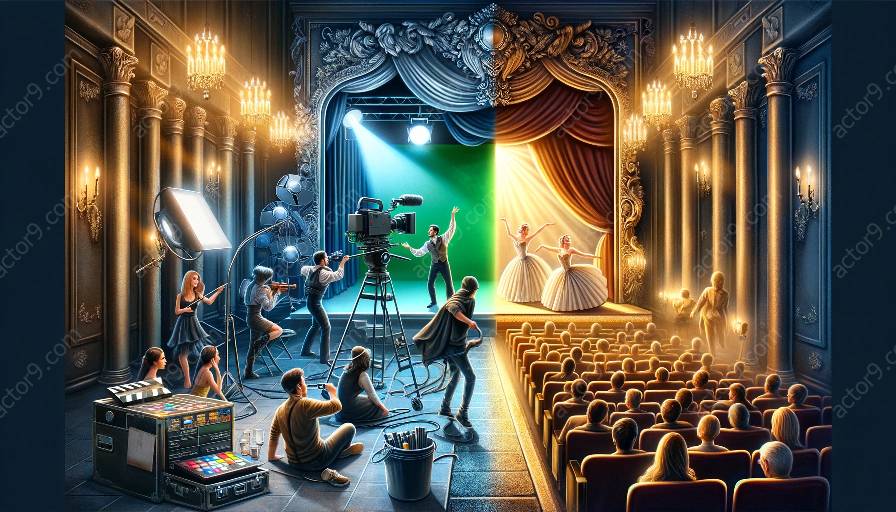When it comes to the art of acting, the use of voice is a critical element that can significantly impact the portrayal of a character. Whether in film or on stage, actors must understand how to utilize their voice effectively to convey emotions, intentions, and messages to their audience. However, the manner in which voice is used differs between film acting and stage acting, as each medium presents unique challenges and opportunities for vocal expression.
Fundamental Differences Between Film Acting and Stage Acting
Before delving into the specifics of voice usage, it's essential to understand the fundamental differences between film acting and stage acting. These variances have a profound impact on how actors approach their performances, including the use of their voices.
Stage acting occurs in live theatrical productions, where performers engage with a physical audience in a shared space. The stage actor must project their voice to fill the theater, ensuring that their delivery reaches all audience members, even those in the back rows. Additionally, stage actors often have to emphasize their vocal expressions and movements to convey emotions and intentions effectively to a larger crowd.
In contrast, film acting is captured through the lens of a camera, allowing for a more intimate portrayal of characters. Actors have the advantage of subtle facial expressions and body language being captured in close-up shots, reducing the reliance on projecting their voice to reach a distant audience. However, the nuanced control of vocal delivery becomes pivotal in conveying emotions and messages effectively within the frame of the camera.
Use of Voice in Stage Acting
Stage actors rely heavily on the projection of their voice to effectively communicate with the audience. The emphasis on vocal projection is crucial, as it allows the actor's voice to carry across the entire theater, ensuring that every audience member can hear and understand the dialogue and emotions conveyed by the characters.
Moreover, the physicality of stage acting necessitates the use of voice in conjunction with movements and gestures to convey emotions and intentions to audience members seated at various distances. This often requires a heightened and exaggerated vocal delivery to ensure that the depth of emotions and messages reaches every corner of the theater.
Furthermore, stage actors need to master vocal techniques such as enunciation, articulation, and vocal modulation to effectively control the volume, pitch, and timbre of their voices. These techniques are essential for conveying the subtleties of a character's emotional state and the nuances of their dialogue to the entire audience.
Use of Voice in Film Acting
Unlike stage acting, film actors have the advantage of microphones and close-up shots, allowing for a more nuanced approach to vocal expression. With the aid of sensitive microphones, film actors can modulate the volume and intensity of their voices to convey emotions and intentions without the need for exaggerated projection.
One of the significant benefits for film actors is the ability to convey emotions through subtle vocal nuances, such as whispering, inflections, and tonal variations, which may not be easily perceivable in a live stage performance. This level of vocal subtlety and intimacy is particularly effective in conveying complex and internalized emotions to the audience.
Additionally, film actors can focus on authentic vocal delivery without the constraint of projecting their voice to reach distant viewers. Furthermore, the controlled environment of film sets allows actors to explore different vocal dynamics and experiment with various delivery styles to enhance the authenticity and depth of their characters.
Adaptation of Voice for Respective Mediums
As actors transition between stage and film performances, they must adapt their vocal techniques to suit the specific requirements of each medium. For stage actors moving to film, the challenge lies in refining their vocal delivery to align with the more intimate and nuanced demands of the camera. This may involve toning down the exaggerated projection and focusing on conveying emotions through subtle vocal modulations and naturalistic deliveries.
Conversely, film actors venturing into stage productions must learn to project their voices effectively to ensure that their dialogue and emotions reach all corners of the theater. They may also need to modify their vocal techniques to accommodate the larger physical space and the demands of live performance, requiring a greater emphasis on vocal projection and clarity.
The Role of Vocal Training
Regardless of the performance medium, vocal training plays a crucial role in shaping an actor's ability to express themselves effectively. Actors often undergo extensive vocal exercises, including breathing techniques, vocal warm-ups, and diction drills, to improve their vocal control and projection.
For stage actors, vocal training focuses on developing the strength and resonance needed to project their voices across large theater spaces while maintaining clarity and emotive power. Conversely, film actors concentrate on cultivating vocal nuances and subtleties to convey emotions convincingly within the confined frame of the camera.
Conclusion
In conclusion, the use of voice in acting varies significantly between film and stage performances. While stage actors emphasize projecting their voices to reach a live audience, film actors leverage the power of close-up shots and sensitive microphones to convey subtle vocal nuances. Both mediums present unique challenges and advantages for vocal expression, ultimately shaping the way actors adapt and employ their voices to convey the depth of their characters' emotions and messages to their audience.















































